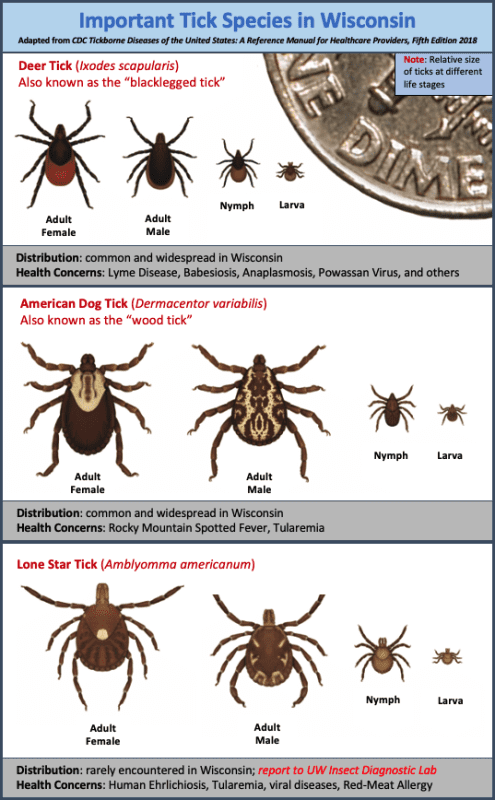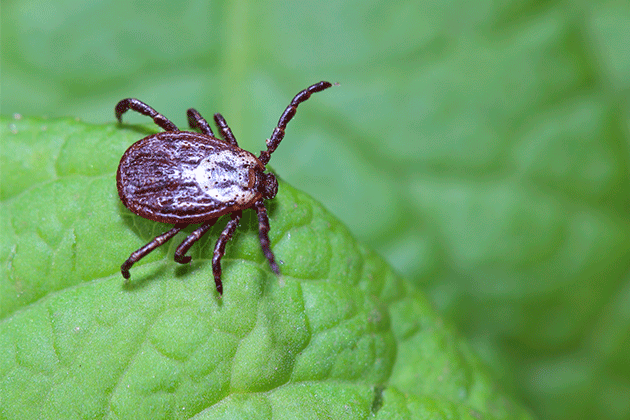
Tick season!

Tick activity increases every day, reaching a peak in May, in the hot summer months ticks are slightly less active, and the second wave of activity occurs in September-October, as ticks prepare for winter, and the last bites are recorded at the end of November.
In summer, in hot weather, ticks look for places in the shade and relative coolness, and are more often found near water bodies, in ravines, in areas of a forest or park overgrown with thick grass and shrubs, wet meadows, wastelands, and even in the city on lawns.
Ticks are slow and wait for people and animals passing through the grass, sitting on blades of grass and branches of bushes at a height of no more than a meter, and spreading their paws wide in order to have time to grab onto clothes or wool. After the tick is on the body, it does not immediately bite where it needs to, but looks for thinner skin: most often it chooses places near the ears, on the neck, in the armpits, on the stomach, between the paw pads, in skin folds, but it can bite into any place on the body and even in the gum, eyelid or nose of the dog.
Contents
Diseases carried by ticks
Babesiosis (Piroplasmosis)
Piroplasmosis is the most common dangerous blood-parasitic disease transmitted through the saliva of the ixodid tick when feeding on the latter. The causative agent – protists of the genus Babesia (Babesia canis in dogs), affect blood cells – erythrocytes, multiply by division, after which the erythrocyte is destroyed, and Babesia occupies new blood cells.
It can take from 2 to 14 days from the moment a dog is infected to the onset of the first symptoms.
Distinguish between acute and chronic course of the disease.
Borreliosis (Lyme disease)
A common disease in Russia. The causative agent is spirochetes of the genus Borrelia, transmitted by ixodid ticks and deer bloodsuckers (elk fly) when bitten. In rare cases, infection is possible when blood is transfused from one dog to another. When a tick bites, bacteria from the salivary glands penetrate into the blood of the bitten animal after 45-50 hours. The incubation period after the penetration of the pathogen into the body lasts 1-2, sometimes up to 6 months. It can be combined with piroplasmosis and ehrlichiosis. In most dogs (80-95%), borreliosis is asymptomatic. In those who have symptoms: weakness, anorexia, lameness, soreness and swelling of the joints, fever, fever, symptoms resolve after an average of 4 days, but in 30-50% of cases they return. Complications can be chronic arthritis, kidney and heart failure, neurological disorders. Borrelia can persist in the human or animal body for a long time (years), causing a chronic and relapsing course of the disease.
erlichiosis
The causative agent is Ehrlichia canis of the genus Rickettsia. Infection occurs with the ingestion of the saliva of the tick with the pathogen, with a bite. It can be combined with any diseases transmitted by ticks – piroplasmosis, etc. The parasite affects the protective blood cells – monocytes (large leukocytes), and then affects the lymph nodes and phagocytic cells of the spleen and liver. The incubation period is 7-12 days. The infection may be asymptomatic for several months, or symptoms may appear almost immediately. Ehrlichiosis can occur in acute, subacute (subclinical) and chronic forms. Acute The temperature rises to 41 ºС, there is fever, depression, lethargy, food refusal and emaciation, the development of vasculitis and anemia, sometimes paralysis and paresis of the hind limbs, hyperesthesia., convulsions. The acute phase passes into the subclinical. Subclinical The subclinical phase can last for a long time. Thrombocytopenia, leukopenia and anemia are noted. After a few weeks, recovery may occur, or the disease may enter a chronic phase. Chronic Lethargy, fatigue, weight loss and poor appetite, slight jaundice, swollen lymph nodes. The work of the bone marrow is disrupted. There are edema, petechial hemorrhages in the skin, mucous membranes, internal organs, nosebleeds, secondary infections. Even after a visible recovery, relapses of the disease are possible.
Bartonellosis
The causative agent is a bacterium of the genus Bartonella. The dog has anorexia, lethargy and apathy, polyarthritis, lethargy, develops endocarditis, heart and respiratory failure. In rare cases, fever, neurological disorders, meningoencephalitis, pulmonary edema, sudden death. It may also be asymptomatic. Treatment of bartonellosis includes the use of antibiotics and symptomatic therapy.
Anaplasmosis
The causative agent is the bacteria Anaplasma phagocytophilum and Anaplasma platys. Carriers are not only ticks, but horseflies, mosquitoes, midges, flies-zhigalki. Bacteria infect erythrocytes, less often – leukocytes and platelets. The incubation period is 1-2 weeks after a tick or insect bite. It occurs in acute, subclinical and chronic forms. The Acute Dog quickly loses weight, refuses to eat, there is a pronounced anemia, jaundice, swollen lymph nodes, and disruption of the respiratory and cardiovascular systems. It proceeds within 1-3 weeks, and the dog either recovers, or the disease flows into a subclinical form. Subclinical Dog looks healthy, the phase can last for a long time (up to several years). There is thrombocytopenia and an enlarged spleen. Chronic Significant development of thrombocytopenia, the dog has spontaneous bleeding and hemorrhage, blood appears in the urine, there is anemia, intestinal atony and intermittent fever. The dog is lethargic, inactive, refuses food. Treatment is with antibiotics, and symptomatic therapy, in severe cases – blood transfusion.
How to protect your dog from ticks
- Be sure to inspect the dog after each walk for the presence of parasites, especially after a walk in the forest or field. On the walk itself, call the dog from time to time and inspect it. At home, you can walk through the coat with a very fine-toothed comb (a flea comb) by placing the dog on a white cloth or paper.
- Treat the pet’s body with anti-tick preparations according to the instructions. There are many options for preparations – shampoos, collars, drops on the withers, tablets and sprays.
- For walks, you can dress your dog in anti-tick overalls. They are made of light-colored breathable fabric, on which ticks will be immediately noticeable, and are equipped with cuffs that prevent ticks from moving around the body. The overalls and especially the cuffs should also be sprayed with tick spray.





